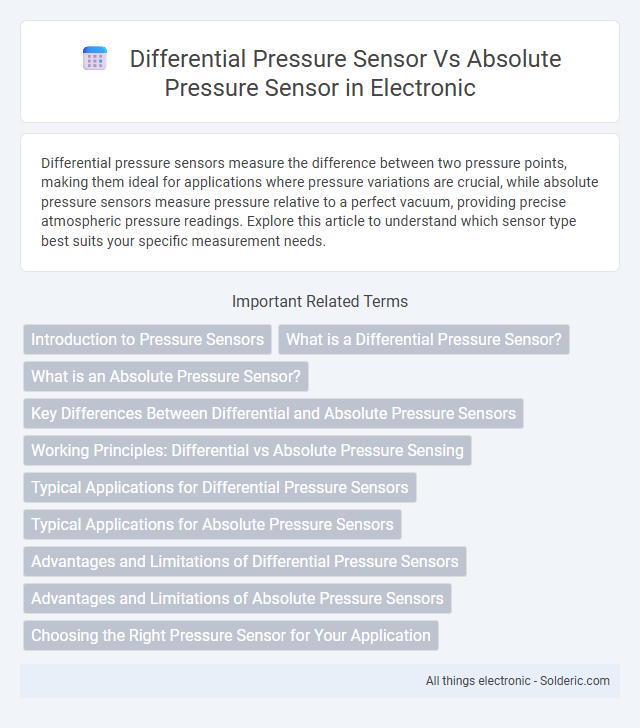Differential pressure sensors measure the difference between two pressure points, making them ideal for applications where pressure variations are crucial, while absolute pressure sensors measure pressure relative to a perfect vacuum, providing precise atmospheric pressure readings. Explore this article to understand which sensor type best suits your specific measurement needs.
Comparison Table
| Feature | Differential Pressure Sensor | Absolute Pressure Sensor |
|---|---|---|
| Measurement | Pressure difference between two points | Pressure relative to a perfect vacuum (zero reference) |
| Reference | Second pressure input (used as reference) | Vacuum sealed reference chamber |
| Applications | Flow measurement, filter monitoring, level measurement | Barometric pressure, altitude measurement, weather stations |
| Accuracy | High for small differences | High absolute accuracy |
| Output | Voltage or current proportional to pressure difference | Voltage or current proportional to absolute pressure |
| Example Sensors | Honeywell SDP810, Omega DPG409 | Bosch BMP388, Honeywell ABP series |
| Environmental Sensitivity | Affected by changes in reference pressure | Less affected due to sealed vacuum reference |
| Cost | Generally lower | Generally higher due to vacuum reference |
Introduction to Pressure Sensors
Pressure sensors measure force exerted by gases or liquids on a surface and are essential in various industrial and scientific applications. Differential pressure sensors detect the difference between two pressure points, often used in filtration or flow measurement, while absolute pressure sensors measure pressure relative to a perfect vacuum, critical for precise scientific and atmospheric data. Both sensor types utilize piezoelectric, capacitive, or strain gauge technologies to convert pressure into electrical signals for accurate monitoring and control.
What is a Differential Pressure Sensor?
A differential pressure sensor measures the difference in pressure between two points, enabling precise monitoring of fluid flow, filter condition, or level measurement in various industrial applications. Unlike absolute pressure sensors, which measure pressure relative to a perfect vacuum, differential sensors provide critical data for systems requiring pressure comparison for control and safety purposes. These sensors are essential in HVAC systems, hydraulic circuits, and process control to ensure efficient operation and prevent equipment damage.
What is an Absolute Pressure Sensor?
An absolute pressure sensor measures pressure relative to a perfect vacuum, providing precise readings unaffected by atmospheric pressure changes. Unlike differential pressure sensors that gauge the difference between two pressure points, absolute sensors are crucial in applications requiring exact pressure values, such as altitude measurement and vacuum systems. These sensors typically use a sealed reference chamber to maintain a stable zero point for accurate and consistent pressure detection.
Key Differences Between Differential and Absolute Pressure Sensors
Differential pressure sensors measure the difference between two pressure points, making them ideal for applications requiring flow or filter monitoring. Absolute pressure sensors measure pressure relative to a perfect vacuum, providing accurate atmospheric or sealed environment readings. Choosing the right sensor depends on whether your system needs relative pressure values or measurements compared to a vacuum baseline.
Working Principles: Differential vs Absolute Pressure Sensing
Differential pressure sensors measure the difference between two pressure points, typically across a filter or an orifice, by detecting the pressure variance between a high-pressure and low-pressure port. Absolute pressure sensors capture pressure relative to a perfect vacuum, providing measurement of total pressure in a system without influence from atmospheric pressure fluctuations. Your choice depends on whether you need to monitor pressure differences within components or the absolute value of pressure in an environment.
Typical Applications for Differential Pressure Sensors
Differential pressure sensors excel in applications such as HVAC systems for monitoring filter status, flow rate measurement in industrial processes, and liquid level detection in pressurized tanks. These sensors provide precise pressure difference readings between two points, which is critical for optimizing system performance and safety. Your ability to maintain efficient fluid dynamics and detect blockages or leaks depends on the accurate data from differential pressure sensors.
Typical Applications for Absolute Pressure Sensors
Absolute pressure sensors are commonly used in applications requiring the measurement of pressure relative to a perfect vacuum, such as in altimeters for aviation, barometers for weather monitoring, and vacuum systems in manufacturing. They provide critical data in environments where precise pressure measurement is essential, including process control in pharmaceuticals and semiconductor fabrication. Your choice of sensor depends on the need to monitor absolute pressure for accuracy in critical systems or environments.
Advantages and Limitations of Differential Pressure Sensors
Differential pressure sensors offer precise measurement of pressure differences between two points, enhancing accuracy in applications like flow rate monitoring and filter condition assessment. Their ability to detect small pressure changes makes them ideal for HVAC systems and fluid control, yet they require careful calibration and can be affected by temperature variations. Despite these limitations, their robustness and high sensitivity make them essential for critical industrial processes requiring accurate pressure differential data.
Advantages and Limitations of Absolute Pressure Sensors
Absolute pressure sensors provide accurate measurements independent of atmospheric pressure, making them ideal for applications in varying environmental conditions such as altitude sensing and vacuum systems. Their main advantage lies in their ability to measure true zero reference pressure, ensuring reliability in critical processes like weather forecasting and industrial vacuum monitoring. Limitations include higher cost and sensitivity to extreme temperature variations, which may require additional compensation mechanisms in complex environments.
Choosing the Right Pressure Sensor for Your Application
Choosing the right pressure sensor depends on the application requirements: differential pressure sensors measure the difference between two points, making them ideal for monitoring flow rates, filter status, or pressure drops. Absolute pressure sensors measure pressure relative to a perfect vacuum, providing accurate atmospheric or sealed system pressure readings critical for altimetry or vacuum processes. Understanding the operating environment and necessary measurement reference ensures optimal sensor selection for precision and reliability.
Differential pressure sensor vs absolute pressure sensor Infographic

 solderic.com
solderic.com